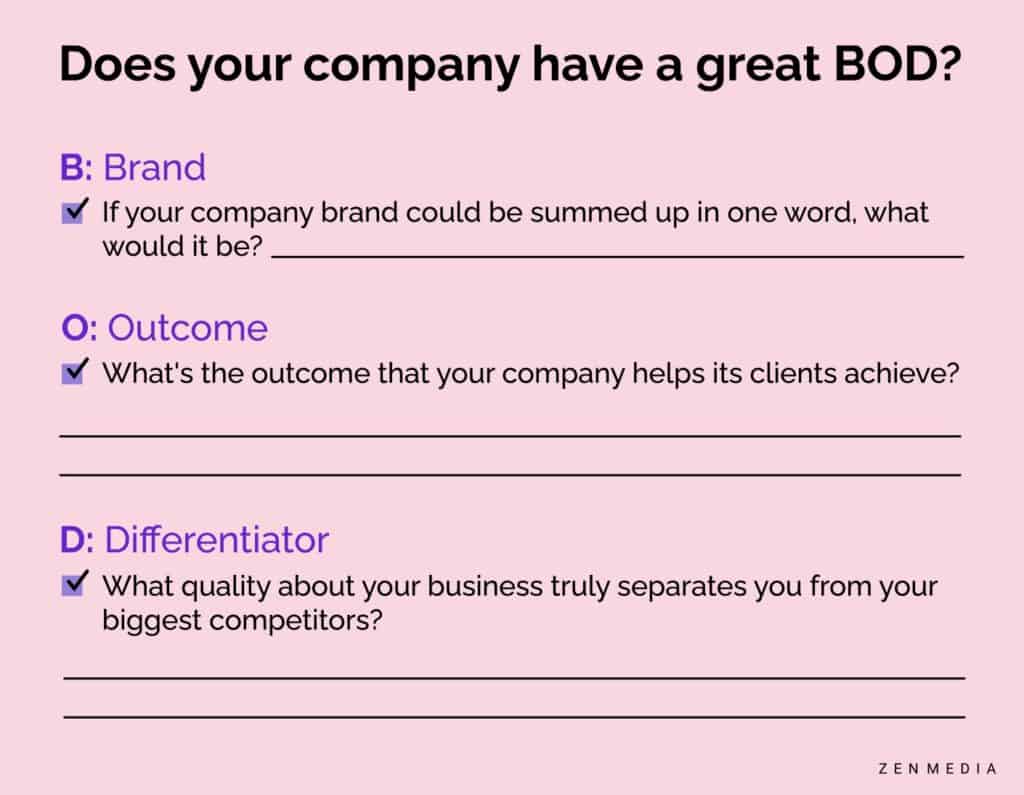Actions speak louder than words.
The infamous phrase is true enough, but how does it apply to your marketing strategy?
It does, we promise.
In order to create a successful B2B marketing strategy, you need to ACT—Attract, Convert, and Transform.
But before you can do that…
You need a great BOD—and we’re not talking about muscles.
Brand
Your company brand is not just your logo or your business message. It’s the total embodiment of your company—from your employees to your products to the way you conduct your business. If your company brand could be summed up in one word, what would it be?
Outcome
The goal of every business is to provide a service or final outcome to their clients and consumers. What’s the outcome that your company helps its clients achieve? Not the process you use but the FINAL result. Sum it up in one line.
Differentiator
What makes your company different than your competitors? And please don’t say price. What makes you inherently different? For example, the online marketing field is a competitive one. However, most companies offer piecemeal services. Some do web design, some consult, and some specialize in B2B SEO. But, no other companies offer all of the strategic and implementation services under one roof—the way we do. That’s one of our key differentiators. We realized that the highest ROI for our clients resides in our ability to provide a turn-key web marketing solution that is customized to their needs! Can you pull out a similar quality about your business that truly separates you from your biggest competitors?

Okay, so now your business has a great BOD…
It’s time to ACT.
Attract
We know from the BOD exercise that you have a clearly defined brand that embodies your company—everything from messaging, logo, voice, and color palette are in alignment. You have a clear understanding of your offerings and the outcomes they bring for your clients, and you have pinpointed your differentiators to craft the perfect brand story.
Now it’s time to get that BOD in front of your audience.
This means that you need to know who your audience is, all of their segmentations, where they get their media, and what will appeal to them—what will attract them.
Here are some tactics to get eyes on your BOD:
- Social Media Marketing: Build a community and create a following on Facebook, Twitter, LinkedIn, Instagram, and more! Cultivate your follower-base by managing that community and performing outreach.
- Earned Media i.e. Public Relations: Secure placements in industry and top-tier publications, podcasts, interviews, and more.
- Blogging: Create content that helps your audience learn more about your BOD and make it easy to locate by using keywords and building your search authority.
- SEO/PPC: Build your website’s search authority by improving your rankings on Google and other search engines, and seek out your customer base with targeted paid ads.
- Videos: Video content performs better than pictures and plain text. According to Forbes, some data shows that consumers spend 88% more time on websites with videos, and 64% are more likely to purchase a product after watching a video about it.
- Mini-Sites: To market a singular product or service outside of your company website—giving you more places to be seen.
- Giveaways: Everyone likes free stuff.
- Joint Ventures: Team up with other relevant companies. Do you already work with a great company? Add their logo to your website, and ask them to add yours to their website. Follow and like their content on social media and ask that they do the same.
Overwhelmed?
You don’t need to do it all at once. Choose 2 of these ideas, then do your research and implement them consistently? Once they’re attracted, where will they go? To your website.
Convert
You’ve attracted them to your website, and the conversion process is imminent, right?
Not necessarily.
Potential customers need at least 27 touchpoints before conversion, according to Forester. Odds are—especially if you are a B2B company—your prospects won’t convert on their first trip to your site, or their second. You need to balance the perusers on the path to conversion with those who are ready to convert ASAP.
You have to cater to people on every spectrum of the marketing rainbow, all at the same time. This means providing great and informative B2B content for those just getting to know your brand, more in-depth content for those who are already familiar and en route to conversion, and content for those that have already converted—blogs, case studies, graphics, testimonials, and more.
We recommend following EMS.
(Another acronym!? Yes. Bear with us.)
EMS (The Online Marketing Version of 911): Educate, Market, and Sell
Some business prospects will need to be educated about your process (educate), others need to know why you are special (marketing), while the rest want to buy (sell).
Whenever someone gets information from your company website, they become consumers.

Not everyone who consumes your company’s information (by signing up for your newsletter, reading your blog, or downloading your article) will become a client of your business immediately. In fact, some of these visitors may never become clients, but they may pass your website on to a friend or recommend you to another colleague who eventually will.
Your company website has to cater to ALL audiences: the consumers, the almost-clients, and the existing (hopefully loyal and ongoing) clients.
The better your ONLINE conversion, the more qualified leads you will have—and that’s how you convert.
Many times, conversion occurs over a period of time. Especially if you are offering a high-ticket product or service. In which case, you will want to attract and nurture leads using online marketing tactics until they are ready to buy.
Transform
Congratulations! You’ve converted your prospect.
So, what now?
You have to deliver.
Once you attract a prospect and turn them into a client, you MUST deliver.
Provide A+ service. Then, gather some sales collateral.
Related reading: Why Sales Collateral Should Be Part of Every B2B Marketing Strategy—And How To Get It
You did a great job; now make sure you get that on record.
Reviews, testimonials, and case studies are all great and influential types of sales collateral. Build strong client relationships, and your clients will likely be happy to share their two cents. Once you get it, make that two cents stretch by sharing it widely. Post case studies on your website and blog. Share testimonials on your social media. Amplify reviews on your website.
No matter how well known your business or organization is, social proof matters!
The process comes full circle.
Doesn’t this process take a long time?
It actually saves time. Having a clear plan and process will help you avoid missteps and time-wasters, and it will ensure that you don’t miss out on prospects in the messy middle of their buyer journey. Imagine a game of baseball. Someone is always on first base, second base, and so forth. The same is true for your prospects. Your job is to keep the game going!
Imagine this scenario: A prospective client from Facebook visits your website and signs up for your newsletter. You have already attracted this individual and turned him into a consumer of your information. At the same time, a veteran subscriber of your blog directly buys your new product after listening to a case study. You have a client. Yet, another individual downloads your free whitepaper. This can all happen simultaneously. You are constantly creating leads and visibility for your business online—as long as you are ACTing.
Online, you can move thousands of prospects at different junctures at the same time. All you need are three things: systems, consistency, and integration.
And after you deliver, you need to keep engaging, keep delivering, and use your experiences as data to improve your strategy.
ACT. It’s one three-letter word, and an amazing marketing strategy.
So how the heck are you going to build a great BOD, educate, market and sell, and ACT on top of everything else? We can help. Reach out.








